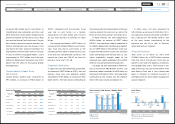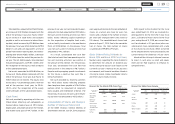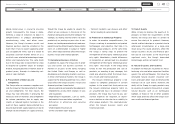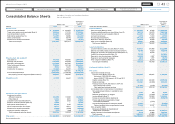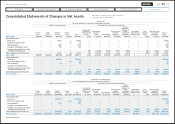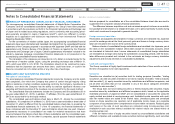Mazda 2014 Annual Report Download - page 42
Download and view the complete annual report
Please find page 42 of the 2014 Mazda annual report below. You can navigate through the pages in the report by either clicking on the pages listed below, or by using the keyword search tool below to find specific information within the annual report.
Forecast for March 2015 Fiscal Year
With regard to the future outlook, although the
U.S. and European economies are expected to
continue their gradual improvement, there is
concern about the effect of the recent con-
sumption tax hike in Japan, and the outlook for
the economies of emerging countries are
expected to remain unclear. Under such cir-
cumstances, the Mazda Group will accelerate
its Structural Reform Plan by, for example,
improving its earnings structure and restruc-
turing its global production footprint.The global
sales volume for the March 2015 fiscal year is
projected to be 1,420,000 units, up 6.7% year
on year. By market, the sales volume projec-
tions are: 230,000 units in Japan (down 5.6%
year on year); 440,000 units in North America
(up 12.7%); 220,000 units in Europe (up 6.4%);
230,000 units in China (up 17.1%); and 300,000
units (up 2.2%) in other markets.
With regard to consolidated financial per-
formance for the March 2015 fiscal year, sales
revenue is projected at ¥2,900 billion (up
7.7% year on year). Operating income and net
income are projected at ¥210.0 billion (up
15.3%) and ¥160.0 billion (up 17.9%), respec-
tively. The exchange rate assumptions are
¥100 to the U.S. dollar and ¥135 to the Euro.
Business Risks
Significant risks that could affect the Mazda
Group’s business results and financial posi-
tion include those listed below.
This list, however, shows the main risks
anticipated at the end of the fiscal year under
review and does not represent a comprehen-
sive list of all the risks faced by the Group.
The forward-looking statements in this sec-
tion are based on the judgments of the Group
as of the end of the fiscal year under review.
1. Economic Conditions Impacting
the Mazda Group
Selling its products in Japan and other parts of
the world, including in North America, Europe,
and Asia, the Group is greatly impacted by eco-
nomic trends and fluctuations in demand in
each of its markets. Therefore, the Group’s
business results and financial position could be
adversely affected by, for example, an eco-
nomic downturn, recession, changes in demand
structure, declining demand, and intensifying
price competition in its main markets.
2. Exchange Rates, Especially the
Dollar-Yen and Euro-Yen Rates
The Group exports products from Japan to
other parts of the world and consequently
its business results and financial position
are exposed to the effects of fluctuations in
exchange rates. An appreciation of the yen,
particularly against the U.S. dollar and
Euro, could lower the Group’s profitability
and ability to compete on price. In addition,
as overseas assets and liabilities denomi-
nated in local currencies are translated into
yen, there could be an adverse effect on
shareholders’ equity through foreign cur-
rency translation adjustments due to
exchange rate fluctuations.
The Group uses forward-exchange con-
tracts and other instruments in some of its
export transactions to minimize the impact
of short-term exchange rate risk. However,
a weakening of the yen could result in
opportunity losses.
3. Alliances and Joint Ventures
The Group is performing or examining joint
activities with other companies under tech-
nology alliances, joint ventures, and in other
forms with respect to the development, pro-
duction, and sales of products. These joint
activities are designed to optimize resources,
facilitate their prioritization, and generate
synergies. However, in the event of a dis-
agreement over management, financial, or
other matters between the parties involved,
or in the event that the expected results were
not produced due to such factors as changes
to or terminations of alliances and joint ven-
tures, the Group’s business results and finan-
cial position could be adversely affected. In
addition, unintended changes to or termina-
tions of alliances and joint ventures could
have an adverse effect on the Group’s busi-
ness results and financial position.
4. Statutory Regulations
Covering the Environment
In addition to being subject to environmental
regulations pertaining to fuel consumption
and exhaust emissions, automobile safety,
and the pollutant emission levels from manu-
facturing plants, the Group’s operations in
each country where it does business are also
subject to various statutory regulations, such
as labor regulations. Going forward, the
Group’s business results and financial posi-
tion could be adversely affected by the
increased costs associated with more strin-
gent statutory regulations.
5. Market Competitiveness
The Group competes with a large number of
companies in automobile markets in all parts
of the world. Maintaining and enhancing the
Group’s ability to compete in these markets,
which includes maintaining and developing
40
Mazda Annual Report 2014
CONTENTS
Foundations Underpinning
Sustainable Growth
Financial Section
Review of Operations
Message from Management
Introduction
Brand Value Management










